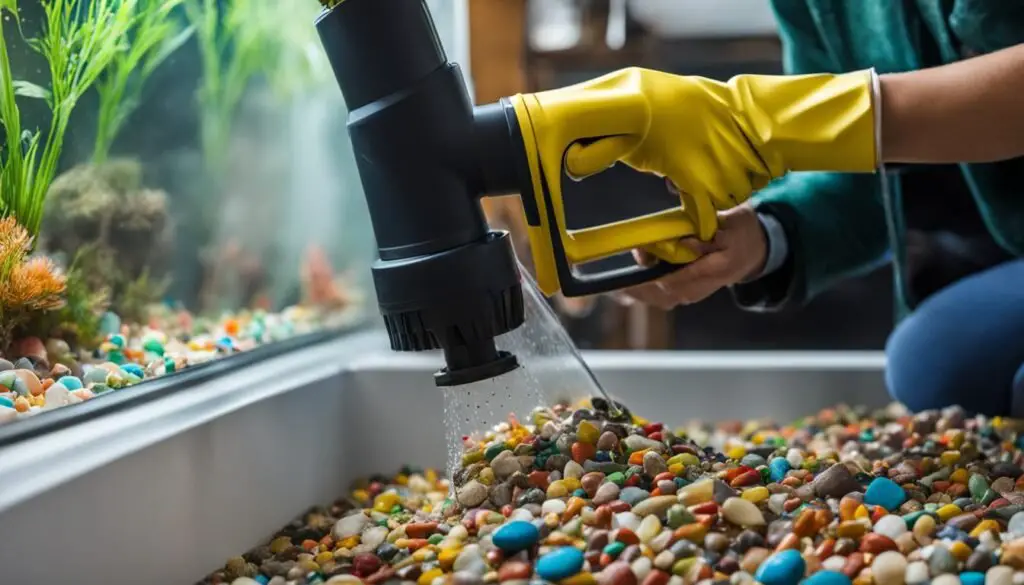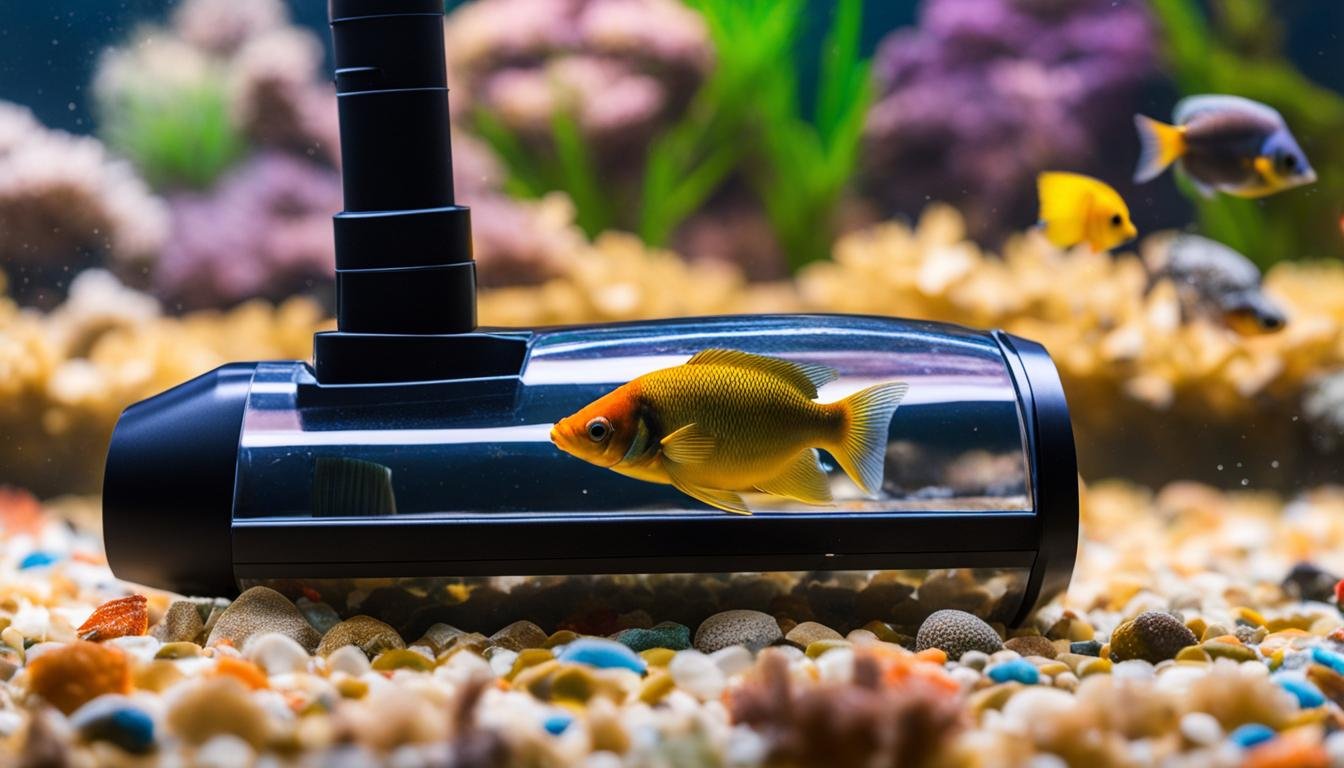Using a gravel vacuum cleaner is an essential part of maintaining a clean and healthy aquarium. It helps to remove fish waste, debris, and harmful substances from the gravel, ensuring a pristine aquatic environment for your fish. In this step-by-step guide, I will walk you through the process of using a gravel vacuum cleaner efficiently and effectively.
To begin, it’s important to gather the necessary materials including an aquarium siphon and a bucket to hold the dirty water. Prepare the tank by moving any aquarium decorations away from the area to be vacuumed and cleaning the filter and algae beforehand. Avoid stressing the fish by not removing them from the tank during the cleaning process. Instead, vacuum around them slowly, ensuring their comfort and well-being.
Once you have the materials and the tank is prepared, it’s time to start the siphon. Submerge the tube of the aquarium siphon in the tank until it fills with water. Raise the tube out of the water and let the water flow into the bucket. When water is freely flowing into the bucket, point the tube opening downwards toward the substrate at the bottom of the tank.
To vacuum the gravel, push the siphon into the gravel or sand and crimp the hose periodically to remove heavy substrate. Vacuum the substrate back and forth in rows, cleaning about a third of the aquarium substrate at a time. This systematic approach ensures a thorough cleaning of the entire gravel bed.
Lastly, once you have finished vacuuming the gravel, it’s time to remove the siphon. Simply lift the siphon out of the water and allow the remaining water to flow back into the tank. Dispose of the dirty water and clean the gravel vacuum cleaner for future use.
Key Takeaways:
- Using a gravel vacuum cleaner is essential for maintaining a clean and healthy aquarium.
- Prepare the tank by moving decorations, cleaning the filter, and algae.
- Start the siphon by submerging the tube and letting the water flow into a bucket.
- Vacuum the gravel methodically, crimping the hose to remove heavy substrate.
- Remove the siphon and dispose of the dirty water.
Getting the Materials and Preparing the Tank
Before you can begin using a gravel vacuum cleaner, it’s important to gather the necessary materials. You will need an aquarium siphon and a bucket to hold the dirty water. These tools will help you efficiently clean the gravel in your aquarium.
Once you have the materials ready, it’s time to prepare the tank for gravel vacuuming. This involves a few important steps to ensure a successful cleaning process. Begin by moving any aquarium decorations away from the area you will be vacuuming. This will allow you easy access to the gravel and prevent any decorations from getting in the way.
Cleaning the filter and algae beforehand is also crucial. A dirty filter can hinder the effectiveness of the gravel vacuum cleaner, so make sure to clean it according to the manufacturer’s instructions. Additionally, algae buildup on the glass walls can be unsightly and affect the overall appearance of your aquarium. Use a magnetic algae scraper to remove any algae from the tank walls before starting the gravel vacuuming process.
It’s worth mentioning that you do not need to remove the fish from the tank. However, to minimize stress on the fish, it is recommended to vacuum around them slowly. Take your time and be gentle as you move the gravel vacuum cleaner through the substrate.
Remember that maintaining a clean and healthy aquarium requires regular maintenance, including gravel vacuuming. By getting the materials ready and preparing the tank properly, you are taking the necessary steps to ensure a successful cleaning process.
Here are the key steps for getting the materials and preparing the tank:
- Gather the necessary materials, including an aquarium siphon and a bucket.
- Move any aquarium decorations away from the area to be vacuumed.
- Clean the filter according to the manufacturer’s instructions.
- Use a magnetic algae scraper to remove any algae from the tank walls.
- Vacuum around the fish slowly to minimize stress.
Starting the Siphon and Vacuuming the Gravel

To effectively clean the gravel in your aquarium, you need to start the siphon and use proper vacuuming techniques. Starting the siphon is essential to ensure that the water flows through the tube and into the bucket, allowing you to remove debris and maintain a clean aquatic environment.
To begin, submerge the tube of the aquarium siphon in the tank until it fills with water. This can be done by holding the tube and immersing it fully into the water. Make sure the tube is sealed tightly, so no air enters the system. If air enters, it can prevent the siphon from working properly.
Once the tube is filled with water, raise it out of the tank and allow the water to flow into the bucket. This creates the siphoning effect, where gravity pulls the water from the tank into the bucket. Keep the tube above the water level in the tank throughout the process to maintain the flow.
When the water is freely flowing into the bucket, it’s time to start vacuuming the gravel. Point the tube opening downwards toward the substrate at the bottom of the tank. By directing the flow of water towards the gravel, you’ll be able to remove debris, fish waste, and leftover food that has settled on the substrate.
*
To effectively vacuum the gravel, push the siphon into the gravel or sand and crimp the hose periodically to remove any heavy substrate that may be stuck. This technique helps to dislodge debris and prevents it from settling back into the tank.
Expert Tip: Vacuum the substrate back and forth in rows, cleaning about a third of the aquarium substrate at a time. This systematic approach ensures thorough cleaning and prevents the transfer of debris from one area to another.
The starting method for the siphon can vary depending on the water level and tank size. Some aquarists find it helpful to use a small clamp to secure the hose temporarily, preventing the water from flowing back into the tank. Others prefer to start the siphon by sucking on the hose end. Regardless of the method you choose, make sure to follow safety precautions and avoid ingesting tank water.
Conclusion
Regular aquarium maintenance is essential for a clean and healthy aquatic environment, and using a gravel vacuum cleaner is a key component of this routine. By following the step-by-step guide and employing proper techniques, you can effortlessly remove fish waste and debris from the gravel without causing undue stress to your fish.
The benefits of using a gravel vacuum cleaner are numerous. Firstly, it helps maintain water quality by eliminating excess waste and harmful substances from the tank. This is vital for the overall well-being of your aquatic pets. Secondly, regular vacuuming prevents the accumulation of debris and pollutants, ensuring a pristine and visually appealing aquarium. A clean environment not only enhances the aesthetic appeal but also promotes the health and longevity of your fish.
Remember to refill your tank with fresh water that matches the temperature of the old water, and add a dechlorinator to remove any toxins. This will help maintain the balance of the aquarium ecosystem. By incorporating regular aquarium maintenance, including the use of a gravel vacuum cleaner, you can create an optimal environment for your fish to thrive in.
So, don’t neglect your aquarium’s cleanliness. Take the necessary steps to ensure regular maintenance that includes the use of a gravel vacuum cleaner. By doing so, you can enjoy the benefits of a clean and vibrant aquarium, providing your fish with a healthy and beautiful habitat.
FAQ
What materials do I need to use a gravel vacuum cleaner?
To use a gravel vacuum cleaner, you’ll need an aquarium siphon and a bucket to hold the dirty water.
How do I prepare the tank for gravel vacuuming?
Before using a gravel vacuum cleaner, move any aquarium decorations away from the area to be vacuumed. It’s also a good idea to clean the filter and algae beforehand.
Do I need to remove the fish from the tank while using a gravel vacuum cleaner?
It’s not necessary to remove the fish from the tank. However, it is recommended to vacuum around them slowly to avoid stressing them.
How do I start the siphon?
To start the siphon, submerge the tube of the aquarium siphon in the tank until it fills with water. Then, raise the tube out of the water and let the water flow into the bucket.
How do I vacuum the gravel?
To vacuum the gravel, point the tube opening downwards toward the substrate at the bottom of the tank. Push the siphon into the gravel or sand and crimp the hose periodically to remove heavy substrate. Vacuum the substrate back and forth in rows, cleaning about a third of the aquarium substrate at a time.
What are the benefits of using a gravel vacuum cleaner?
Regular use of a gravel vacuum cleaner helps maintain water quality and prevents the buildup of harmful substances in the tank. It contributes to a clean and healthy aquarium environment for your fish.
How often should I use a gravel vacuum cleaner?
It is recommended to use a gravel vacuum cleaner at least once a month to ensure proper maintenance of the aquarium. However, the frequency may vary depending on the size of the tank and the number of fish.





Leave a Reply